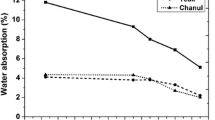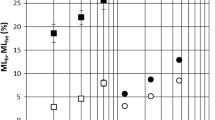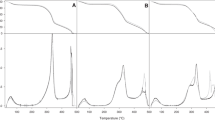Abstract
Heat treatment of wood has been found an effective method to improve dimensional stability and durability against biodegradation. A two-stage heat treatment of wood at relatively mild conditions (<200 °C) was investigated by using different chemical analysing methods, such as a wood chemical component analysis, CHNO-elemental analysis, UV-spectroscopy, and analysis of the acetyl and free hydroxyl group content. The results of this study contribute to a better understanding of the typical reaction mechanisms occurring and of the effect of heat treatment on the properties of wood, as described in previous 13C-NMR and FTIR studies of heat treated wood.
Zusammenfassung
Die Wärmebehandlung von Holz hat sich als ein wirksames Verfahren zur Verbesserung der Dimensionsstabilität und Fäuleresistenz erwiesen. In dieser Studie wurde eine zweistufige Wärmebehandlung von Holz unter relativ milden Bedingungen (<200 °C) untersucht. Dabei wurden verschiedene chemische Analyseverfahren, wie zum Beispiel chemische Analyse der Holzbestandteile, CHNO-Elementaranalyse, UV-Spektroskopiesowie Analyse des Acetylgehalts und der freien Hydroxylgruppen angewandt. Die Ergebnisse dieser Studie tragen zu einem besseren Verständnis der auftretenden Reaktionsmechanismen sowie der Wirkung einer Wärmebehandlung auf die Eigenschaften von Holz bei, die bereits in früheren 13C-NMR und FTIR Studien über wärmebehandeltes Holz beschrieben wurden.
Similar content being viewed by others
References
Abatzoglou N, Koeberle PG, Chornet E, Overend RP, Koukios EG (1990) An application to medium consistency suspension of hardwoods using a plug flow reactor. Can J Chem Eng 68:627–638
Baeza J, Freer J (2001) Chemical characterization of wood and its components. In: Hon DN-S, Shiraishi N (eds) Wood and cellulosic chemistry. Marcel Dekker Inc, New York, pp 275–384
Belkacemi K, Abatzoglou N, Overend RP, Chornet E (1991) Phenomenological kinetics of complex systems: mechanistic condiderations in the solubilization of hemicellulose following aqueous/steam treatment. Ind Eng Chem Res 30:2416–2425
Bobleter O, Binder H (1980) Dynamischer hydrothermaler Abbau von Holz. Holzforschung 34:48–51
Boonstra MJ, Tjeerdsma BF, Groeneveld HAC (1998) Thermal modification of non-durable wood species. Part 1, The Plato technology: thermal modification of wood. International Research Group on Wood Preservation, Document no. IRG/WP 98-40123
Boonstra MJ, Pizzi A, Tekely P, Pendlebury J (1996) Chemical modification of Norway spruce and Scots pine. A 13C NMR CP-MAS study of the reactivity and reactions of polymeric wood components with acetic anhydride. Holzforschung 50:215–220
Bourgois J, Guyonnet R (1988) Characterization and analysis of torrified wood. Wood Sci Technol 22:143–155
Browning BL (1967) Methods of wood chemistry. John Wiley & Sons, Inc, New York
Burmester A (1973) Einfluss einer Wärme-Druck-Behandlung halbtrockenen Holzes auf seine Formbeständigkeit. Holz Roh- Werkst 31:237–243
Burmester A (1975) Zur Dimensionsstabilisierung von Holz. Holz Roh- Werkst 33:333–335
Faix O, Böttcher JH (1992) The influence of particle size and concentration in transmission and diffuse spectroscopy of wood. Holz Roh- Werkst 50:221–226
Fengel D (1980) Experiments on the alkaline extraction of polyoses from spruce holocellulose. Das Papier 34(10):428–433
Fengel D, Wegener G (1984) Wood: Chemistry, Ultrastructure, Reactions. Walter de Gruyter & Co, Berlin New York, pp 66–105
Fukazawa K (1992) Ultraviolet microscopy. In: Lin SY, Dence CW (eds) Methods in lignin chemistry. Springer, Berlin, p 578
Giebeler E (1983) Dimensionsstabilisierung von Holz durch eine Feuchte/Wärme/Druck-Behandlung. Holz Roh- Werkst 41:87–94
Goldschmid O (1971) Ultraviolet spectra. In: Sarkanen KV, Ludwig CH (eds) Lignins. Occurrence, formation, structure and reactions. Wiley Interscience, New York London Sidney Toronto, pp 241–266
Hillis WE (1984) High temperature and chemical effects on wood stability. Part 1, General considerations. Wood Sci Technol 18:281–293
Hon DNS (1991) Photochemistry of wood. In: Hon DN-S, Shiraishi N (eds) Wood and cellulosic chemistry. Marcel Dekker Inc, New York Basel, pp 525–555
Okamura K (2001) Structure of cellulose. In: Hon DNS, Shiraishi N (eds) Wood and cellulosic chemistry. Marcel Dekker Inc, New York Basel, pp 83–108
Sakakibara A (2001) Chemistry of lignin. In: Hon DNS, Shiraishi N (eds) Wood and cellulosic chemistry. Marcel Dekker Inc, New York Basel, pp 109–173
Ishii T, Shimizu K (2001) Chemistry of cell wall polysaccharides. In: Hon DN-S, Shiraishi N (eds) Wood and cellulosic chemistry. Marcel Dekker Inc, New York, pp 175–212
Kollmann F, Fengel D (1965) Änderungen der chemischen Zusammensetzung von Holz durch thermische Behandlung. Holz Roh- Werkst 21(3):77–85
Kollmann F, Schneider A (1963) Über dass Sorptionsverhalten wärmebehandelter Hölzer. Holz Roh- Werkst 41:87–94
Kumar S (1994) Chemical modification of wood. Wood Fiber Sci 26(2):270–280
Militz H, Beckers EPJ, Homan WJ (1997) Modification of solid wood: Research and practical potential. International Research Group in Wood Preservation, Document No IRG/WP 97-40098
Noack D (1969) Über die Heisswasserbehandlung von Rotbuchenholz im Temperaturbereich von 100 bis 180 °C. Holzforsch Holzverwert 21(5):118–124
Pizzi A, Stephanou A, Boonstra MJ, Pendlebury AJ (1994) A new concept on the chemical modification of wood by organic anhydrides. Holzforschung 48:91–94
Pott GT (2004) Natural fibers with low moisture sensitivity. In: Natural fibers, plastics and composites, Chapter 8, Kluwer Academic Publishers, ISBN 1 4020 7643 6
Rowell RM (1983) Chemical modification of wood. Forest Prod Abstr 6(12):363–382
Rowell RM (1984) The chemistry of solid wood. American Chemical Society, Washington DC 84
Rowell RM (1984b) Penetration and reactivity of cell wall components. In: The chemistry of solid wood. American Chemical Society, Washington DC, pp 175–210
Rowell RM, Simonson S, Hess DV, Plackett DV, Cronshow D, Dunningham E (1994) Acetyl distribution in acetylated whole wood and reactivity of wood cell-wall components to acetic anhydride. Wood Fiber Sci 26:11–18
Rubio Torres M, Heitz M, Chauvette G, Chornet E (1986) Conversion and solubilization profiles of a prototype hardwood (Populus tremuloides) following aqueous thermomechanical pre-treatment. Biomass 10:85–96
Seborg RM, Tarkow H, Stamm AJ (1953) Effect of heat upon the dimensional stabilisation of wood. J For Prod Res Soc 3(9):59–67
Spurr AR (1969) A low viscosity epoxy resin embedding medium for electron microscopy. J Ultrastruct Res 26:31–43
Stamm AJ (1964) Wood and cellulose science. Ronald Press, USA, pp 312–342
Tjeerdsma BF, Boonstra M, Militz H (1998) Thermal modification of non-durable wood species. Part 2, Improved wood properties of thermally treated wood. International Research Group on Wood Preservation, Document No IRG/WP 98-40124
Tjeerdsma BF, Boonstra M, Pizzi A, Tekely P, Militz H (1998) Characterisation of thermally modified wood: molecular reasons for wood poerformance improvement. Holz Roh- Werkst 56:149–153
Tjeerdsma BF, Militz H (2005) Chemical changes in hydrothermal treated wood: FTIR analysis of combined hydrothermal and dry heat-treated wood. Holz Roh- Werkst 63:102–111
Viitaniemi P, Jämsä S (1996) Modification of wood by heat treatment. VTT publications 814
Weiland JJ, Guyonnet R (1997) Retifiziertes Holz. 16. Verdichter Holzbau in Europa, Motivation, Erfahrung, Entwicklung, Dreilander Holztagung, 10. Joanneum Research Fachtage, 2.-5.11.1997, Grazer Congress, Grazz, Austria
Wise LE, Murphy M, D’Addieco AA (1946) Chlorite holocellulose, its fractionation and bearing on summative wood analysis and studies on the hemicelluloses. Paper Trade J 122(2):35–43
Author information
Authors and Affiliations
Corresponding author
Rights and permissions
About this article
Cite this article
Boonstra, M., Tjeerdsma, B. Chemical analysis of heat treated softwoods. Holz Roh Werkst 64, 204–211 (2006). https://doi.org/10.1007/s00107-005-0078-4
Published:
Issue Date:
DOI: https://doi.org/10.1007/s00107-005-0078-4




